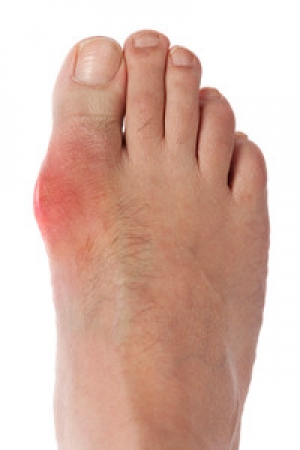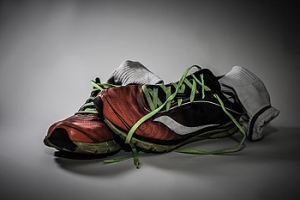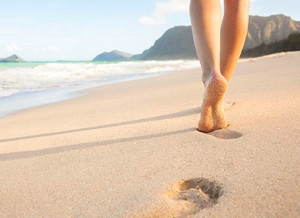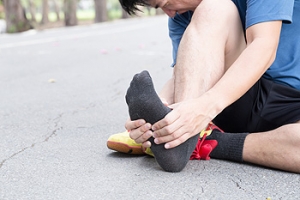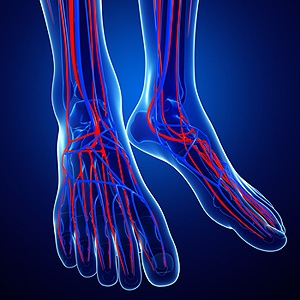Super User
Excess Uric Acid May Cause Gout
 When uric acid crystals accumulate in the joints, it may cause a painful condition known as gout. More often than not, gout originates in the big toe, and if left untreated may cause complications. The joints will often feel swollen and stiff, in addition to severe pain being experienced. Gout most often affects middle aged people, the majority being male who may have a hereditary predisposition for it. It is also more common in people who are overweight or drink alcohol in excess. Health issues may also be a factor in causing this condition, including high blood pressure or an underactive thyroid gland. Treatment may begin with lifestyle changes and a balanced diet, in addition to medications prescribed to reduce uric acid in the blood. Please consult a podiatrist if you think you may have gout for treatment options for this painful condition.
When uric acid crystals accumulate in the joints, it may cause a painful condition known as gout. More often than not, gout originates in the big toe, and if left untreated may cause complications. The joints will often feel swollen and stiff, in addition to severe pain being experienced. Gout most often affects middle aged people, the majority being male who may have a hereditary predisposition for it. It is also more common in people who are overweight or drink alcohol in excess. Health issues may also be a factor in causing this condition, including high blood pressure or an underactive thyroid gland. Treatment may begin with lifestyle changes and a balanced diet, in addition to medications prescribed to reduce uric acid in the blood. Please consult a podiatrist if you think you may have gout for treatment options for this painful condition.
Gout is a foot condition that requires certain treatment and care. If you are seeking treatment, contact one of our podiatrists from Westside Podiatry Center, LLP. Our doctors will treat your foot and ankle needs.
What Is Gout?
Gout is a type of arthritis caused by a buildup of uric acid in the bloodstream. It often develops in the foot, especially the big toe area, although it can manifest in other parts of the body as well. Gout can make walking and standing very painful and is especially common in diabetics and the obese.
People typically get gout because of a poor diet. Genetic predisposition is also a factor. The children of parents who have had gout frequently have a chance of developing it themselves.
Gout can easily be identified by redness and inflammation of the big toe and the surrounding areas of the foot. Other symptoms include extreme fatigue, joint pain, and running high fevers. Sometimes corticosteroid drugs can be prescribed to treat gout, but the best way to combat this disease is to get more exercise and eat a better diet.
If you have any questions please feel free to contact one of our offices located in Liverpool, Camillus, Skaneateles, Oswego, and Cicero, NY . We offer the newest diagnostic and treatment technologies for all your foot and ankle needs.
Everything You Need to Know About Gout
Gout, typically found in diabetic patients, is an unusually painful form of arthritis caused by elevated levels of uric acid in the bloodstream. The condition typically strikes the big joint on the big toe. It has also been known to strike the knees, elbows, fingers, ankles and wrists—generally anywhere that has a functioning, moving joint.
The high level of uric acid in a person’s bloodstream creates the condition known as hyperuricema—the main cause of gout. Genetic predisposition occurs in nine out of ten sufferers. The children of parents who suffer gout will have a two in ten chance of developing the condition as well.
This form of arthritis, being particularly painful, is the leftover uric acid crystallizing in the blood stream. The crystallized uric acid then travels to the space between joints where they rub, causing friction when the patient moves. Symptoms include: pain, redness, swelling, and inflammation. Additional side effects may include fatigue and fever, although reports of these effects are very rare. Some patients have reported that pain may intensify when the temperature drops, such as when you sleep.
Most cases of gout are easily diagnosed by a podiatrist’s assessment of the various symptoms. Defined tests can also be performed. A blood test to detect elevated levels of uric acid is often used as well as an x-ray to diagnose visible and chronic gout.
Treatment for gout simply means eliminating symptoms. Non-steroid anti-inflammatory drugs or NSAIDs (Colchicine and other corticosteroid drugs, etc.) will quell the redness, the swelling, and the inflammation. However, managing your diet, lifestyle changes, and using preventative drugs are all helpful toward fully combating the most severe cases.
Those that lead an inactive lifestyle are at a higher risk for gout. Any amount of exercise decreases the probability of repeat encounters with the condition. Reducing your consumption of red meat, sea food, and fructose-sweetened drinks also reduces the likelihood of chronic gout as well.
Ingesting Vitamin C, coffee, and particular dairy products can help with maintaining a healthy lifestyle. There are new drugs out on the market that inhibit the body’s production of uric acid-producing enzymes. However, reducing or eliminating your overall levels of uric acid is the best remedy to ensuring you lead a gout-free life.
Treatments for Sweaty Feet
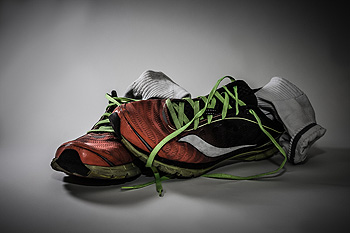 Sweaty feet is a common condition that most people find uncomfortable, and it’s often associated with an unpleasant odor in addition to a soggy feeling in the shoes and socks. Wet feet often lead to problems such as fungal infections, usually stemming from bacteria that live in warm and moist areas. Synthetic shoes socks may possibly make this condition worse, so it’s advised to wear cotton socks and leather shoes or sandals. It’s important to change your socks often and walking barefoot whenever possible may also help allow your feet to breathe. Please consult with a podiatrist if you have questions about hyperhidrosis of the feet.
Sweaty feet is a common condition that most people find uncomfortable, and it’s often associated with an unpleasant odor in addition to a soggy feeling in the shoes and socks. Wet feet often lead to problems such as fungal infections, usually stemming from bacteria that live in warm and moist areas. Synthetic shoes socks may possibly make this condition worse, so it’s advised to wear cotton socks and leather shoes or sandals. It’s important to change your socks often and walking barefoot whenever possible may also help allow your feet to breathe. Please consult with a podiatrist if you have questions about hyperhidrosis of the feet.
If you are suffering from hyperhidrosis contact one of our podiatrists of Westside Podiatry Center, LLP. Our doctors can provide the care you need to attend to all of your foot and ankle needs.
Hyperhidrosis of the Feet
Hyperhidrosis is a rare disorder that can cause people to have excessive sweating of their feet. This can usually occur all on its own without rigorous activity involved. People who suffer from hyperhidrosis may also experience sweaty palms.
Although it is said that sweating is a healthy process meant to cool down the body temperature and to maintain a proper internal temperature, hyperhidrosis may prove to be a huge hindrance on a person’s everyday life.
Plantar hyperhidrosis is considered to be the main form of hyperhidrosis. Secondary hyperhidrosis can refer to sweating that occurs in areas other than the feet or hands and armpits. Often this may be a sign of it being related to another medical condition such as menopause, hyperthyroidism and even Parkinson’s disease.
In order to alleviate this condition, it is important to see your doctor so that they may prescribe the necessary medications so that you can begin to live a normal life again. If this is left untreated, it is said that it will persist throughout an individual’s life.
A last resort approach would be surgery, but it is best to speak with your doctor to find out what may be the best treatment for you.
If you have any questions please feel free to contact one of our offices located in Liverpool, Camillus, Skaneateles, Oswego, and Cicero, NY . We offer the newest diagnostic and treatment technologies for all your foot and ankle needs.
Hyperhidrosis of the Feet
Hyperhidrosis of the feet, also termed plantar hyperhidrosis, is characterized by excessive sweating of the feet that can be onset by any cause, such as exercise, fever, or anxiety. Most people suffering from hyperhidrosis of the feet also experience hyperhidrosis of the hands, or palmar hyperhidrosis. Approximately 1-2% of Americans suffer from this disorder.
Sweating is a healthy process utilized by the body in order to cool itself and maintain a proper internal temperature, which is controlled by the sympathetic nervous system. In individuals with hyperhidrosis, the sympathetic nervous system works in "overdrive", producing far more sweat than is actually needed.
Plantar hyperhidrosis is considered primary hyperhidrosis. Secondary hyperhidrosis refers to excessive sweating that occurs in an area other than the feet, hands, or armpits, and this indicates that is related to another medical condition, such as menopause, hyperthyroidism, or Parkinson's disease.
Symptoms of hyperhidrosis of the feet can include foot odor, athlete's foot, infections, and blisters. Because of the continual moisture, shoes and socks can rot which creates an additional foul odor and can ruin the material, requiring shoes and socks to be replaced frequently. In addition to the physical symptoms, emotional health is often affected as this disorder can be very embarrassing.
If left untreated, hyperhidrosis will usually persist throughout an individual's life. However, there are several treatment options available. A common first approach to treating hyperhidrosis of the feet is a topical ointment. Aluminum chloride, an ingredient found in antiperspirants, can be effective at treating hyperhidrosis if used in high concentration and applied to the foot daily. Some individuals can experience relief this way, while others encounter extreme irritation and are unable to use the product. Another procedure is the use of Botulinum Toxin A, commonly referred to as Botox. This is injected directly into the foot, and is effective at minimizing the sweat glands in the injected area. These injections must be repeated every 4 to 9 months.
If these treatments are ineffective, oral prescription medications may be taken in an effort to alleviate the symptoms. Again, some will experience relief while others do not. Going barefoot reportedly provides relief for most sufferers.
A final approach to combating hyperhidrosis of the feet is through surgery. Surgery has been less successful on patients with plantar hyperhidrosis than on those with palmar hyperhidrosis. It is only recommended when sweating is severe and other treatments have failed to work. This kind of surgery usually involves going into the central nervous system, and cutting nerves to stop the transmission of signals telling the foot to sweat.
Is Barefoot Running Right for You?
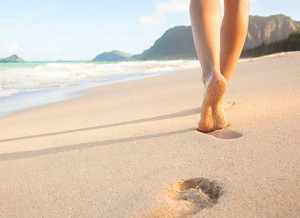 While running barefoot may just seem to be the newest fad in recent years, its emergence spawned decades ago. African barefoot runners Abebe Bikila and Zola Budd both set world records back in the 1960’s and 80’s respectively. Researchers have noted there is less impact on the foot when running barefoot compared to running in shoes--that means less potential for injuries. However, it is important to consult a podiatrist before running barefoot. Furthermore, it is best to ease into running barefoot, as this will help accustom your feet to the ground and prevent any potential injuries.
While running barefoot may just seem to be the newest fad in recent years, its emergence spawned decades ago. African barefoot runners Abebe Bikila and Zola Budd both set world records back in the 1960’s and 80’s respectively. Researchers have noted there is less impact on the foot when running barefoot compared to running in shoes--that means less potential for injuries. However, it is important to consult a podiatrist before running barefoot. Furthermore, it is best to ease into running barefoot, as this will help accustom your feet to the ground and prevent any potential injuries.
Barefoot running has its own share of benefits and disadvantages. If you have any concerns about your feet or ankles, contact one of our podiatrists from Westside Podiatry Center, LLP. Our doctors will treat your foot and ankle needs.
Barefoot Running
The Impact of Barefoot Running
- Running without shoes changes the motion of your running, as most running is done by landing on the heel of the feet.
- Running barefoot requires a different way of running; the landing is done on the front part of the feet.
The Advantages of Barefoot Running
- When running and landing on the front feet, the impact on the feet and ankle is reduced; this can reduce stress injuries.
- It strengthens muscles in the feet, ankles and lower legs.
- Balance of the body is improved, and there is a greater sensory input from the feet to the rest of the body.
The Drawbacks of Barefoot Running
- No protection while running, makes it likely that runners will land on sharp objects and scrapes, bruises and cuts on the feet will result.
- Blisters may form.
- Possibility of plantar fascia problems.
- Risk of getting Achilles tendonitis.
So, what can runners do to make barefoot running safe? It’s best to make a slow transition from running shoes to barefoot running. Once the feet begin to adjust, try walking, then jogging and gradually increasing the distance. Minimalist running shoes may also be an option.
If you have any questions please feel free to contact one of one of our offices located in Liverpool, Camillus, Skaneateles, Oswego, and Cicero, NY . We offer the newest diagnostic and treatment technologies for all your foot and ankle needs.
Barefoot Running
Barefoot running is becoming a more and more popular running trend throughout the running and jogging communities. However, running without shoes also affects the motions of your stride. When barefoot running, choosing to run without shoes is not the only adjustment you will have to make.
Whenever you run normally with shoes, your heel strikes the ground first as you land while you roll over the ball of your foot and push off with the front part and toes. Barefoot runners land on the front part of their feet and not their heels. This shifts the impact from the back to the front of the foot. In order to do this safely and without much injury, runners need to reduce their stride to create softer landings.
One of barefoot running’s biggest advantages is the reduced risk of injury. Landing on the front of your foot with a reduced stride lessens the stress placed on the back of the foot, heels, and ankles. It also works out many muscles in the feet, ankles, and lower legs that you do not normally get to strengthen because of the different motions. Your posture and balance are also improved with barefoot running, as is your sensory input from your feet to the rest of your body. Studies have shown that countries that have large populations of people who do not wear shoes every day are at lower risk for foot and ankle injuries and complications.
However, there is still some skepticism behind barefoot running because of some disadvantages it brings. One of these is the complete lack of protection for your feet while running. Bruises, scrapes, cuts, and even blisters can easily form when you have no protection from sharp or rough objects on the ground. Landing on the front of your feet can also cause Achilles tendonitis because of the overuse of the Achilles tendon.
Despite this, barefoot running can be made safe and enjoyable if you make a slow transition from your normal running routine into barefoot running. Rather than jumping straight into barefoot running, gradually work your way from walking to jogging to running, increasing the distance each time. It is also recommended to start off on flat, even surfaces that do not contain sharp or dangerous objects because your feet are unprotected. Minimalist running shoes are a great middle ground to start with because they combine the protection of shoes with the fit and feel of barefoot running.
Different Types of Flat Feet
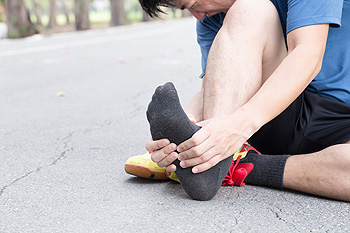 Well-developed arches in the feet provide the necessary balance the body needs to achieve maximum flexibility and stability. When this arch is not developed, the condition is called flat feet, also known as fallen arches. Babies are typically born with flat feet, and the arch generally develops in childhood. Recent research has shown there are two types of flat feet: flexible and rigid. A partial arch is noticeable in the patient that has flexible flat feet, while there is no arch present at all in rigid flat feet. As the aging process transpires, there may be several reasons why flat feet develop, including weight gain and possible foot injuries. Runners with this condition may find that choosing shoes to wear while jogging that offer additional support may feel more comfortable. It’s suggested to consult with a podiatrist for a proper diagnosis or for additional information.
Well-developed arches in the feet provide the necessary balance the body needs to achieve maximum flexibility and stability. When this arch is not developed, the condition is called flat feet, also known as fallen arches. Babies are typically born with flat feet, and the arch generally develops in childhood. Recent research has shown there are two types of flat feet: flexible and rigid. A partial arch is noticeable in the patient that has flexible flat feet, while there is no arch present at all in rigid flat feet. As the aging process transpires, there may be several reasons why flat feet develop, including weight gain and possible foot injuries. Runners with this condition may find that choosing shoes to wear while jogging that offer additional support may feel more comfortable. It’s suggested to consult with a podiatrist for a proper diagnosis or for additional information.
Flatfoot is a condition many people suffer from. If you have flat feet, contact one of our podiatrists from Westside Podiatry Center, LLP. Our doctors will treat your foot and ankle needs.
What Are Flat Feet?
Flatfoot is a condition in which the arch of the foot is depressed and the sole of the foot is almost completely in contact with the ground. About 20-30% of the population generally has flat feet because their arches never formed during growth.
Conditions & Problems:
Having flat feet makes it difficult to run or walk because of the stress placed on the ankles.
Alignment – The general alignment of your legs can be disrupted, because the ankles move inward which can cause major discomfort.
Knees – If you have complications with your knees, flat feet can be a contributor to arthritis in that area.
Symptoms
- Pain around the heel or arch area
- Trouble standing on the tip toe
- Swelling around the inside of the ankle
- Flat look to one or both feet
- Having your shoes feel uneven when worn
Treatment
If you are experiencing pain and stress on the foot you may weaken the posterior tibial tendon, which runs around the inside of the ankle.
If you have any questions please feel free to contact one of our offices located in Liverpool, Camillus, Skaneateles, Oswego, and Cicero, NY . We offer the newest diagnostic and treatment technologies for all your foot and ankle needs.
Flat Feet
Flatfoot is a foot condition in which the arch of the foot has either partially or totally dropped or has never developed. While it is common in babies and small children, it can become a problem for them in adulthood if the arch never forms. For adults, the development of flat feet can be brought upon by injury, as a result of pregnancy due to increased elasticity, or obesity. Those who have health concerns such as rheumatoid arthritis or diabetes may also be at greater risk for developing the condition.
If you suspect that you have flat feet, it is best to consult your podiatrist. Your foot doctor will examine the suspected foot and observe how it looks while you sit and stand. He or she may take an X-ray to determine how serious the condition is. Some common signs of flatfoot include toe drift, in which the toes and front part of the foot point outward, a short Achilles tendon, and a heel that tilts outwardly while the ankle tilts inward.
Once flatfoot has been diagnosed, your podiatrist may suggest one of several treatment options. Flat feet can be rigid, in which the feet appear to have no arch even when the person is not standing; or flexible, in which the person appears to have an arch while not standing, but once standing the arch disappears. Those with flexible flatfoot may be told to reduce any activities that cause pain and to avoid extended periods of walking or standing. Another suggestion may be weight loss, as excessive weight may be placing pressure on the arches
In few cases, if the condition is severe and all other methods have been exhausted surgery may be required. This is normally avoided, however, due to a lengthy recovery time and high cost.
Can Airplane Travel Affect Circulation?
 If you’ve been on an airplane for several hours, you may know that circulation problems in the feet can develop. It typically occurs when your feet have limited mobility due to small areas. The formation of blood clots can be a result of poor circulation and can be prevalent in diabetics. Generally, the symptoms are easily noticed and may consist of tingling, pain, and swelling in the area where the clot has formed. There are several ways to protect the feet from poor circulation, and these may include avoiding foods that are salty, stretching the feet as often as possible, and walking up and down the aisle of the airplane. If you experience symptoms of this ailment, please schedule a consultation with a podiatrist for more information on ways to avoid poor circulation.
If you’ve been on an airplane for several hours, you may know that circulation problems in the feet can develop. It typically occurs when your feet have limited mobility due to small areas. The formation of blood clots can be a result of poor circulation and can be prevalent in diabetics. Generally, the symptoms are easily noticed and may consist of tingling, pain, and swelling in the area where the clot has formed. There are several ways to protect the feet from poor circulation, and these may include avoiding foods that are salty, stretching the feet as often as possible, and walking up and down the aisle of the airplane. If you experience symptoms of this ailment, please schedule a consultation with a podiatrist for more information on ways to avoid poor circulation.
Poor circulation is a serious condition and needs immediate medical attention. If you have any concerns with poor circulation in your feet contact one of our podiatrists of Westside Podiatry Center, LLP. Our doctors will treat your foot and ankle needs.
Poor Circulation in the Feet
Poor blood circulation in the feet and legs is can be caused by peripheral artery disease (PAD), which is the result of a buildup of plaque in the arteries.
Plaque buildup or atherosclerosis results from excess calcium and cholesterol in the bloodstream. This can restrict the amount of blood which can flow through the arteries. Poor blood circulation in the feet and legs are sometimes caused by inflammation in the blood vessels, known as vasculitis.
Causes
Lack of oxygen and oxygen from poor blood circulation restricts muscle growth and development. It can also cause:
- Muscle pain, stiffness, or weakness
- Numbness or cramping in the legs
- Skin discoloration
- Slower nail & hair growth
- Erectile dysfunction
Those who have diabetes or smoke are at greatest risk for poor circulation, as are those who are over 50. If you have poor circulation in the feet and legs it may be caused by PAD and is important to make changes to your lifestyle in order to reduce risk of getting a heart attack or stroke. Exercise and maintaining a healthy lifestyle will dramatically improve conditions.
As always, see a podiatrist as he or she will assist in finding a regimen that suits you. A podiatrist can also prescribe you any needed medication.
If you have any questions please feel free to contact one of our offices located in Liverpool, Camillus, Skaneateles, Oswego, and Cicero, NY . We offer the newest diagnostic and treatment technologies for all your foot and ankle needs.
Causes, Symptoms, and Treatment of Poor Blood Circulation in the Feet
Poor blood circulation in the feet and legs is often caused by peripheral artery disease (PAD), which is usually the result of a buildup of plaque in the arteries. Plaque buildup, or atherosclerosis, can be the result of excess calcium and cholesterol in the bloodstream. This restricts how much blood can flow through arteries. Reduced blood flow to a certain area of the body severely limits the amount of oxygen and nutrients that part of the body receives. This leads to degeneration in the muscles and other tissues. Sometimes, poor blood circulation in the feet and legs can be caused by other conditions, such as the damaging or inflammation of blood vessels, known as vasculitis.
The lack of oxygen and nutrients caused by poor blood circulation can restrict muscle growth and development, as well as cause muscle pain and cramps, weakness, and stiffness. Other common symptoms include numbness in the legs and feet, skin discoloration in the affected limbs, slower nail and hair growth, and erectile dysfunction in men. In more severe cases of PAD, pain can be present even when a person isn't exercising, and may range from mildly uncomfortable to completely debilitating.
Poor blood circulation in the feet and legs is more common in those who are overweight or obese, have diabetes, high blood pressure, high cholesterol, who smoke, or who have a family history of PAD or related conditions such as a heart attack, stroke, etc. Diabetes and smoking place a person at greatest risk for developing poor blood circulation, although advanced age, over 50, can also increase risk.
If you are experiencing poor blood circulation in the feet and legs caused by PAD, it is important to make changes to your lifestyle in order to reduce your risk of experiencing a heart attack or stroke caused by this condition. If you smoke, quit completely. This will increase the amount of oxygen in your bloodstream. Exercising and reducing the saturated fats in your diet. Saturated fats come from fatty meats, fried foods, whole milk, etc., can make a difference in improving blood circulation in feet. It is also important to avoid developing influenza and to carefully control your blood sugar if you have diabetes.
Your doctor may recommend combining lifestyle changes with a prescription medication regimen to improve blood circulation. The most commonly-used medications for PAD are called statins and work by blocking the amount of enzymes in your body that produce cholesterol. They are known by the brand names Zocor, Lipitor, Crestor, and others.
